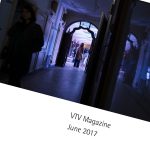Riappropriazione, presented by Converso, is an art installation at the church San Paolo Converso in Milan, Italy, that totally covers the inside of the church. Since the early 1970s the Italian artist Franco Mazzuchelli has created environmental installations, in which inflatable volumes of joined sheets of polyethylene are made walkable and livable. Depending on whether they are mounted in private interiors or outdoors, Mazzucchelli’s installations are called Sostituzioni (substitutions) or Riappropriazioni (re-appropriations). Both are intended to alter the perception of a familiar space.
Franco Mazzucchelli (Milan, 1939) lives in Milan. He was professor of Techniques of Sculpture at the Brera Academy of Fine Arts, in Milan. His works have been shown in historical exhibitions, including “Volterra ’73” (1973), the 15th Milan Triennale (1973), the 37th Venice Biennale (1976) and the 11th Rome Quadrennial (1986).
The church of San Paolo Converso is a converted church in the historic center of Milan. Since 2014 it is the headquarter of CLS architects. The architects use the church also for exhibitions, installations and events related to the art and design world.
Franco Mazzucchelli: Riappropriazione. Converso at the church San Paolo Converso in Milan, Italy. March 31, 2017. The installation was on view from 26 February to 1 April 2017.
> Right-click (Mac: ctrl-click) this link to download Quicktime video file.
Press text:
From February 26 to April 1, 2017, Converso presents “Riappropriazione,” an exhibition of Milan-based artist Franco Mazzucchelli.
Since the early 1970s Franco Mazzucchelli has created environmental installations, in which inflatable volumes of joined sheets of polyethylene are made walkable and livable. These installations are called Sostituzioni [substitutions] or Riappropriazioni [re-appropriations], depending on whether they are mounted in private interiors or outdoors. Both the Substitutions and the Re-appropriations are intended to disrupt the perception of a familiar place, be it a domestic environment or an urban fragment, and to open a getaway from daily routine by suggesting an unfamiliar view of the surrounding space. In the case of Re-appropriations, this attempt brackets out and isolates a portion of public space and exhorts people to take over that space and redefine it—ultimately, to rediscover the potential of public space to solicit spontaneous socialization, in which human encounters are freed of hierarchy, and class, gender and ethnic differences become effaced. The Re-appropriations produce the occasion for people to regard their own local community and the built environment with genuine curiosity.
We want to think that the installation Franco Mazzucchelli has created for Converso, although it is mounted in an interior space, falls within the “category” of the Re-appropriations. Not only does it inaugurate the program of a new exhibition space, encouraging the transformation of a public space with its own layered history of functions, but it opens a social space, or a platform alien to the authority of the social time that “out there” instead administers society. With this Re-appropriation we therefore abandon any providential design associated with this place, embracing instead a policy of horizontality and concreteness.
Outside the church we invited the artist to present occasionally a sculpture from the series called Abbandoni [abandonments], inflatable objects, made of PVC, conceived to be dispersed in the urban landscape and freely appropriated by people. Our Abandonment resembles a chain—paradoxically rendered open and soft, it is inefficient, a mere simulacrum of power. Like past Abandonments that became both playgrounds for children and barricades for striking workers, this chain asks people to make of it what they will—they may, if they like, if they feel threatened by its symbolic value, tear it down once and for all.
Franco Mazzucchelli (Milan, 1939) lives in Milan. He was professor of Techniques of Sculpture at the Brera Academy of Fine Arts, in Milan. His works have been shown in historical exhibitions, including “Volterra ’73” (1973), the 15th Milan Triennale (1973), the 37th Venice Biennale (1976) and the 11th Rome Quadrennial (1986).




